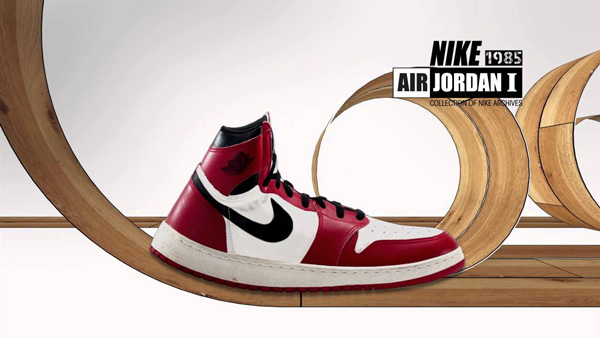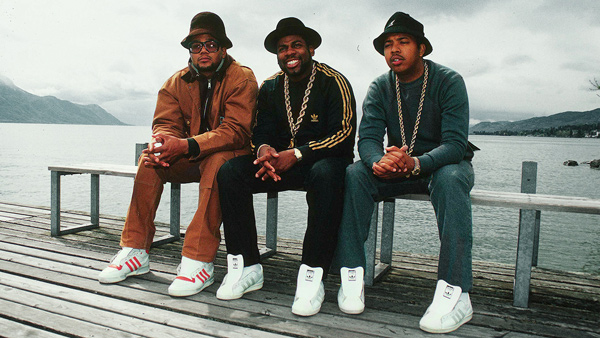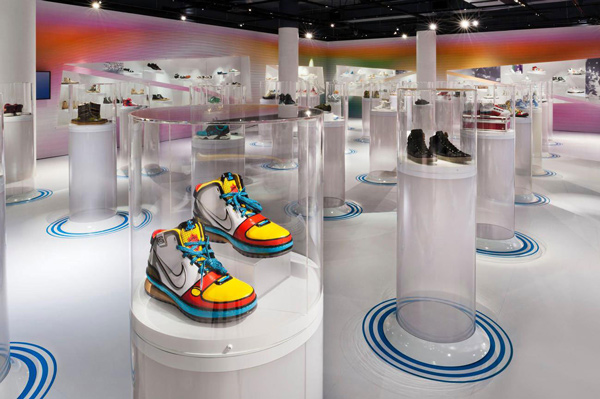The Cult of Sneakers: how this shoe went from crime to catwalk

It was 1989, and a boy had just been murdered for his shoes.
Not just any pair of shoes, though; it was a pair of Air Jordans, a shoe that sneakerheads will tell you has been touched by greatness, but also on that day, by terror - retold in horrific detail by Sports Illustrated in this seminal coverstory.
Cut to 2012 when 22-year-old Joshua Woods was killed on his way home from a mall in Texas for his new limited-edition Air Jordans.
These are horrific stories. But they are also the cultural markers that illuminate what a niche group has always known - and which the rest of the world has now caught up to.
Sneakerheads are a tribe. Sneakers are a cult.
They are coveted as art. They have collectors and auctions. They have gallery-like stores. Limited editions. Designer collaborations. Certified fanatics.
There is, in short, a massive subculture of people for whom sneakers have long been the holy grail. Except now, that obsession has left the niche and entered the mainstream.
Sneakers are having a moment
Shoes have been typically considered a female frivolity but sneakers - fundamentally male in their origin, even though now equally worn by women - have an incredibly complex social history.
They've been around for over a century - invented around 1895, mass production began in 1917 - but it is this year that they've hit drawing-room conversation.
To mark the cultural significance and stunning rise of the genre, an exhibition titled The Rise of Sneaker Culture opened on July 10 at New York's Brooklyn Museum of Art and will run till October 4.
It includes sneakers dating from an 1860 spiked running shoe to those designed by Damien Hirst, Jeremy Scott and Kanye West. It also includes an extraordinary lineup from the private archives of Nike, Adidas, Reebok, Converse and Bata's own superb museum.
On the same day Elizabeth Semmelhack, chief curator of the exhibition, released a book, Out of the Box: The Rise of Sneaker Culture with a superb roster of interviews, essays and photographs that examine the political and cultural role of the sneaker. Already, it's been tagged one of 2015's best books, a definitive work in this genre.
The foot fetish doesn't end here. This Autumn, London's V&A museum has an exhibition on shoes - not limited to sneakers - lined up. Together, the two exhibitions should trace the entire known history and evolution of footwear.
How sneakers left the sports arena
If you'd asked sneakers back in 1917, when they first began to be mass-produced, what they'd like to be when they grew up, they'd probably have said crime's best choice.
After all, they got the nickname sneakers because they were so quiet, a person wearing them could sneak up on someone without warning.
The name sneakers came about because they were so quiet, a person wearing them could sneak up on you without warning
Invented around 1895 for athletic purposes, they were part of professional sport gear for about half a century before entering the Physical Education (PE) curriculum of post-war schools worldwide.
From underground culture to high fashion, sneakers are the great equaliser
By the 70s, it was common to carry a pair to school for PE. It's telling, however, that schools restricted them to the field and indoor sports, and strictly enforced the divide between school shoes and sport shoes. Sneakers were firmly embedded in our culture as something not to be worn at formal settings.
It wasn't any different for adults.
Barred from clubs and banished from any respectful gathering for decades, it was a sartorial and cultural crime to wear them to 'civilised' occasions.
Not only were they an outcast from formal dressing, they were also shunned from casual high-end fashion, and only occasionally showed up in everyday lifestyle wear.
Things began to change in the '70s when jogging took off - suddenly, sportswear showed up on the street, and in cafes and in places other than the field - but it wasn't till the '90s when, quite dramatically, the concept of 'Smart Casual' hit the imagination.
It seemed to coincide with an all-round slackening of rules for men's dressing.
By the late 90s and early 2000s, the tie began to be taken less seriously in the men's formal suit and was discarded completely by early trendsetters.
At the same time, the groundwork was being laid for the democratisation of fashion. If on the one hand, formal was easing up, on the other, the distance between ramp and real was blurring.
And then the sneaker sneaked into the office
It started with the concept of Friday dressing, a way for workplaces to loosen up; for people to bring aspects of their weekend selves - or personal selves - into the office.
As 'personality' began to be more accepted at work, men started becoming more experimental with their look - and into this vaccum incredibly clever marketing inserted the sneaker.
How 'Just Do It' came to signal talent and transgression
One of the factors that helps something become 'fashionable' is transgression.
Something shocking pitted against something established is risky - but it gets you noticed. If done properly, it can set off a countertrend.
In 1978, when Nike signed up the bad boy of tennis John McEnroe - famous for his outbursts on-court - to launch their 'Rebel with a Cause' campaign, they may not have been endorsing bad behaviour, but they were certainly rewarding individuality and, to some extent, transgression.
But the best was still to come.
It was 1985. Nike had as endorser the hot new talent Michael Jordan and they had just launched an exclusive new pair of sneakers: the Air Jordan.

The Air Jordans that kicked off sneakerhead culture
But the NBA mandated that shoes worn on the court had to be in the dominant colours of that team's jerseys. But while the Chicago Bulls jerseys were red and white, the Air Jordans were red-and-black.
Which got them banned.
Jordan wore them anyway. And was fined a hefty $5,000 for the transgression.
Nike happily paid the fine, proverbially putting its money where its mouth was: Just Do It.
Not just once either; Jordan wore them for many subsequent on-field appearances that NBA season, he continued to be fined, Nike continued to pay.
It was eventually Stern who relented.
In the process, Michael Jordan became an icon: of incredible talent, yes, but also of individuality and defiance. And the subtext of the whole Air Jordan controversy - which Jordan and Nike only benefitted from - seemed to be, these shoes are worth it.
According to CNN, "the shoe's (Air Jordan's) public release in 1985 is widely considered the catalyst for modern sneakerhead culture - a community of sneaker collectors and admirers who follow new releases with a dedication usually reserved for classic cars or Swiss watches."
Eric Cantona had a trademark upturned collar on his Man U shirt and inarguably, an attitude to match
Jordan wasn't Nike's only maverick endorser, either. There was also Eric Cantona, nicknamed King Eric by Manchester United fans and voted their greatest player ever.
He had a trademark upturned collar on his No 7 Man U shirt and inarguably, an attitude to match.
Through his career he was dogged by disciplinary troubles, the last being an eight-month ban in 1995 where he was convicted for assaulting a fan with a kung-fu flying kick. But it was hard, also, to contest his greatness as a football player and his role in Manchester United's fortunes as one of the world's most iconic football clubs.
Nike quickly appropriated the transgression theme - including through 'Banned' Air Jordan commercials - and found incredible success. During the 80s and 90s, they accounted for over 50% of the sports shoe market in the US.
But what it did for the category as a whole was even more remarkable - there was widespread adoption of sneakers among the youth with an accompanied admiration and attachment to transgressing stars.
At the same time, hip-hop was gaining influence
It was around the same time that another former outlier was turning cool: hip-hop.
The genre was gaining ground as a reaction to the Europeanised disco music that was the flavour of the time.
Hip-hop had an intimate relationship with transgression. It started out as an underground genre and its signalling - from its lyrics to its visual and aural cues - only pushed that association further.
Take the unofficial dress code of rappers during the late 80s and early 90s - sneakers without laces and oversize jeans worn low at the hip with the underwear waistband visible.
Both were style transgressions that actually found their roots in criminal behaviour: before being sent to their cells, prisoners are made to hand over their belts and shoelaces to prevent suicide, attack and strangling of other cellmates - the result is lace-free shoes with a raised flap and low-slung trousers.
Since a spell here was considered mandatory by many rappers, the style became a sign of fellowship and an important part of this new culture outside prison.
As hip-hop gained mainstream acceptance, being beamed directly into homes via MTV in the 80s, this outlaw-style of clothing gathered its own cult, with sneakers at the heart of this expression.
This imagery and association worked beautifully for sneaker companies.

Hip-hop group Run DMC sporting Adidas shoes
Rap lyrics - part of the hip-hop genre - were extensions of a constant struggle between the dominant white society and the disadvantaged, mostly black, minorities.
It was a struggle that found the empathy of adolescents and youth across the world - thanks to their own struggles against parental and societal authority.
Brands including Nike, Adidas, Reebok and Converse appropriated this kind of cool, hard, urban imagery and reached out to this subculture, though initially in less overt ways.
Looking at the racial politics of sneakers, Semmelhack writes, "young African-American men weren't so much being advertised to as they were being advertised through."
Sneakers claimed their significance on the feet of African-American men and that went on to become a status symbol of great importance. By 1980, for instance, approx 75% of NBA players were African-American, according to Semmelhack, and these high-achieving athletes were selling sneakers hard and fast to inner city kids.
The sneakerhead culture was born.
It didn't hurt that rocket science got involved
It's a contemporary truisim that adding technology to virtually anything immediately amps up its 'want' factor.
So, too, with sneakers.
You didn't have to be a rocket scientist to buy the Nike Air, but it did involve Nike collaborating with technology from NASA.
Adidas and Reebok weren't far behind.
In the 80s, Reebok slid seamlessly into the aerobics phenomena and pumped up the volume with its 'Step Reebok' and Freestyle Aerobics technology for women. Turnover shot up by almost 9 times in 2 years.
Later, in 1989, they launched the 'Pump' technology that went on to power some of their most successful lines of sneakers.
Adidas - which, incidentally, was Michael Jordan's real favourite shoe brand before he signed up with Nike, recently launched their Ultra Boost line, touted as the greatest running experience you will ever have. Starting at Rs 6,500 a foot - or approx Rs 13,000 a pair - geekery on your feet doesn't come cheap.
But technology is now an inextricable part of the appeal.
Phil Knight, co-founder of Nike, said to Harvard Business Review in 1992 that 'technology, design and functional elements' are at the core of the big marketing theatre of sneakers.
If early tech adoption was about performance, it's now as much about appearance, and the new jargon reflects that.
Turns out sneakers are rocket science: Nike collaborated with NASA to create the technology that powers the Nike Air
A new collaboration between Adidas and Japanese retailer Atmos for instance has a pair that looks plain white in the day but lights up neon in the dark; shoes that some describe as 'work-to-night leisure transitional' equipment.
It sounds like an off-roader SUV perfect for mud roads but also promises to be a good drive to work.
In that, the modern sneaker is to shoes "what sports utility vehicles are to other cars: large, loaded with impressive but rarely-used options, a statement less of need than of desire" according to Tom Vanderbilt, author of The Sneaker Book: Anatomy of an Industry and an Icon.
The final frontier: where no sneaker had gone before
Fashion isn't a stranger to transgression, but sneakers on the runways of high fashion continued to evoke a mixed response.
There were, of course, occasional adopters; brands like Gucci gave a nod to the subculture as long ago as the mid 80s. But they remained niche.
Things changed quite dramatically as consumers took charge of their own styling. Their influencers - athletes, musicians, those with cool cred - were warm and alive. Models on the ramp on the other hand were distant, cool. Ramp shows have their appeal, but their very inaccessibility made their style less appealing in the real world.
Barring a period in the 90s when supermodels like Cindy Crawford, Claudia Schiffer, Naomi Campbell, Christy Turlington and Kate Moss became bonafide stars - and thus had a deep connect with the audience - the style of models didn't resonate with audiences as much as the stars.

The Rise of Sneaker Culture, an exhibition running at New York's Brooklyn Museum of Art
It wasn't overnight, but the distant catwalks of Paris and Milan slowly lost their hold over the do's and don't of fashion in favour of the vibrant, alive imagery that Levi's, Nike and Gap represented.
Luxury didn't lose its appeal, but its rigidity did.
The first serious acceptance of this cataclysmic change came when Chanel's Karl Lagerfeld joined hands with H&M in 2004 for their first designer collaboration.
Everything from the line in every single H&M store - from the US to France - sold out within hours of the collection's release.
Words like mass-tige (mass-prestige), mass-luxe entered the lexicon.
According to Mark Tungate, author of the influential Fashion Brands: Branding Style from Armani to Zara, "tracksuit-wearing rappers and the chino-clad super-nerds of the dotcom boom were the new icons; 'casual Friday' elided into the rest of the week. The elitist stance once taken by fashion brands began to look stuffy and - horror of horrors - old-fashioned."
Fashion loosened up, and sport brands wisened up.
Reebok was the first sneaker brand to claim the fashion - and women - space while Nike, Adidas and Puma were still claiming athletic cred in the 80s and 90s.
Adidas bounced back, separating their business into three distinct strategic units - including one for fashion collaborations, the most successful of which has been Y-3, their hyper-successful range with Yohji Yamamoto.
But it was the edgier among the luxury fashion houses that spotted this opportunity - the hesitation of athletic brands to veer too far from their sports origins - and stepped in to fill the gap.
Sneakers had acquired their newest influencers: the likes of Marc Jacobs, Prada, Gucci, Christian Louboutin and Louis Vuitton. Suddenly, the suit wasn't only shown on the ramp with a hard-toe leather shoe - it showed up with a pair of sneakers.
Off the ramp, it was a trend that was surprisingly easy to adopt - because it liberated wearers of the suit from associations of predictability and stuffiness.
A man in a suit? We know who he is. A man in a suit wearing a pair of Stan Smiths? Let's get to know this guy.
Video compiled by Adiba Muzaffar







![BJP's Kapil Mishra recreates Shankar Mahadevan’s ‘Breathless’ song to highlight Delhi pollution [WATCH] BJP's Kapil Mishra recreates Shankar Mahadevan’s ‘Breathless’ song to highlight Delhi pollution [WATCH]](http://images.catchnews.com/upload/2022/11/03/kapil-mishra_240884_300x172.png)

![Anupam Kher shares pictures of his toned body on 67th birthday [MUST SEE] Anupam Kher shares pictures of his toned body on 67th birthday [MUST SEE]](http://images.catchnews.com/upload/2022/03/07/Anupam_kher_231145_300x172.jpg)


_251372_1280x720.jpg)
_251371_1280x720.jpg)


